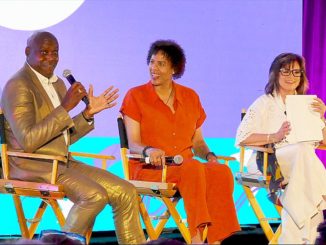
● From our sister site, TheSportsExaminer.com ●
Back on 1 June 2022, 1996 Atlanta Olympic double gold medalist Michael Johnson published a lengthy Twitter thread that included:
● “1/7 I asked what sport represents a successful example of what track & field could be or should be. In the thread below I have listed my response to some of the replies, and end with my opinion what the sport needs to achieve it’s potential.”
● “4/7 Tennis/Golf. Individual sports, most comparable to track. 4 ‘Majors’ every year serve as the pinnacle. T&F calendar is confusing & crowded. Olympics, World Champs, 14 Diamond League events. All presented as major, but Olympics is ‘The Major’, and not controlled by the sport.”
On Tuesday, Johnson unveiled “Grand Slam Track,” a new venture to launch in 2025, closely modeled on the golf and tennis model:
● Four meets per year, with the first in April and three over the summer, but toward the beginning of the season. One meet will take place in the Los Angeles area, another in the U.S. and two more outside of the U.S. The sites have been selected, but the announcements will be made later.
● The program will include just 96 athletes – all in track, no field – with 48 “Racers” contracted to compete annually in all four “Slams,” and who will receive a salary for their participation, but also be eligible for prize money. Another 48 will be contracted, with an appearance fee, to compete in one or more Slams, based on their performance. A “Grand Slam Track Racing Committee” will make the decisions on invitations.
● Each “Slam” will take place over three days, in a three-hour daily television window with competition in six groupings, in which the athletes will race in two events:
= Short sprints (100 m/200 m)
= Short hurdles (100 m hurdles or 110 m hurdles/100 m)
= Long sprints (200 m/400 m)
= Long hurdles (400 m hurdles/400 m)
= Short distance (800 m/1,500 m)
= Long distance (3,000 m/5,000 m)
Athlete placings in their two events will be scored 10-8-6-5-4-3-2-1. Assuming both groups are held for men and women each time, there will be eight athletes per event group, and 96 athletes per meet.
● Winners of each event group will win $100,000 in prize money, with further awards for places 2-8 of $50,000-30,000-25,000-20,000-15,000-12,500-10,000.
The prize money total per event group is $262,500 and for each Slam, a total of $3.15 million, so $12.60 million for all four Slams in total.
The emphasis is on competition, with no pacesetters or pacing lights, and athletes will wear their own uniforms, with no bibs. No teams, everything is on the individual athlete. And 400 m hurdles world-record holder and Olympic gold medalist Sydney McLaughlin-Levrone has been signed as the first “Racer” athlete.
The introductory news release explained the funding: “Grand Slam Track has secured more than $30 million in financial commitments from investors and strategic partners for the launch of the league. Winners Alliance, a global, athlete-centric commercial solution and Johnson’s operating partner, was the lead investor in the first fundraising close for the new venture.”
Tuesday was the start, and there are still more questions than answers. No information on meet dates, ticket prices or television partners was provided, but with more details promised over the summer.
¶
Michael Johnson introduced his Grand Slam Track program at a 31-minute presentation in Los Angeles, hosted by ESPN anchor John Anderson and featuring Sydney McLaughlin-Levrone and Carl Lewis, who has been pushing the issue of athlete pay since the 1980s.
Johnson started with, “It’s an exciting day” and went on to explain how he sees his project:
● “This is a new day for track and field. … This new league will revolutionize the sport, bring track back to the forefront, and make sure that going forward that athletes in this sports and fans in this sport get what they’ve been asking for, for so many years now.”
● “Right now, we are witnessing the greatest collection of amazing personalities in this sport. I have never seen so many amazing personalities all at once, in the sport, willing to put themselves out there, wanting to connect with their fans, and these athletes are doing a great job already with their social media.
“We are also seeing performances at a level we haven’t seen in quite some time, so the performances, the athletes are at a level that is unprecedented.
“In addition to that, in sports in general, we are seeing we are seeing a level of investment in sport and interest in sport at an all-time level. So, there’s been no better time that I’ve seen in the last 30 years or so where track and field as a sport is positioned to just explode and that’s what we’re doing with Grand Slam Track.”
● “Our 48 Grand Slam Track Racers compete in all four “Slams” throughout the year; the other four challengers can actually unlock a lane during the season for one or more of those Slams. But the great thing about this league is that we now have athletes under contract who compete against one another four times a year and are guaranteed to be there. That’s what our fans have been asking for in track and field: the ability to see the athletes, know that they are going to be there and that’s it’s going to be the best against the best. …
“During the season, as athletes run fast times, they enter the conversation as a challenger, they enter the conversation as one of the best in that event … we have the ability now with our committee – if we select that person – to bring them in.”
McLaughlin-Levrone, who trains in Los Angeles, came on to express her enthusiasm for the concept, saying:
“Very excited to be a part of this endeavor. Michael’s done a great job putting this together and just knowing that the future of track and field can grow exponentially and that athletes will have the opportunity to just grow this sport and it’s in a place ready to do that. …
“I’m so excited to just be a part of a real, professional track league.”
She also touched on very limited competition schedule and why she is interested in the new project:
“Because track is so kind of sporadic in how it’s set up, people expect crazy times and crazy performances every time they see us because they don’t see us that often. And I think this will kind of normalize seeing people through training cycles, in different parts of their training, but still seeing the best of the best compete, to the point where they’re just enjoying the fact that we get to race one another.
“And seeing a good race, as opposed to always expecting something amazing and spectacular.”
Lewis, the nine-time Olympic gold medalist who is now the coach at the University of Houston, endorsed the idea of essentially a four-meet tour:
“If you go to any Grand Slam in tennis or golf, you know the best are going to be there, so you actually plan to watch the U.S. Open because you know they’ll be there. Right now, you don’t know that.”
He also emphasized the athlete-first aspect of the Grand Slam Track idea:
“Now, everyone’s making their own schedule, and the best thing about this to me is it allows you to know, ‘this is the schedule,’ ‘this grand Slam is going to be here every single year,’ the dates are not going to change and we know what the benefits are, financially.
“This would have been great [for past athletes] and it gives the athlete more of a control, outside of the federation. Right now, World Athletics owns everything: they own the Diamond League, they own the Continental [Tour], so this is something that is separate from it and I think it can grow. And in the long run, I think they are going to have to change to fit into what is happening with this league.”
Johnson also explained why field events are not part of the program:
“We don’t have field events in Grand Slam Track. And the reason for that is one of the other things that has been a long-standing problem in the sport – and I’ve been on the television side with the BBC for 24 years – and I see how we struggle to bring that casual viewer in, and even the avid viewer and story-tell around the competition because we have so many things happening at once.
“So we are committed to one event at a time. You will not see multiple things happening when you’re watching a Grand Slam Track event on television, or attending in person. With one event at a time, in a three-hour window, there is no place for us to fit field events. … We’re committed to allowing these athletes to be the center of focus, the center of attention when their event comes on and they are the only thing happening on the track.”
Clearly, from the athlete standpoint, the money is what will make the difference:
“Our prize money pool is the biggest in the history of track and field.
“At the end of the day, these athletes deserve to be compensated for their talent and what they bring and we’re doing that. … Athletes are saying, finally we’re going to be paid and recognized for our talent as we should be and commensurate with our talent and on par with athletes from other sports.”
Following up on Lewis’s comments, Anderson made a point to ask Johnson about how Grand Slam Track will fit in with everything else – the Diamond League, Continental Tour and other events – that is currently going on:
“There has not been a specific league for the best-of-the-best athletes. … The true fastest athletes deserve their own league, and that doesn’t exist. And that’s what this is.
“This can sit alongside everything else that exists in the sport. There is a need for those races within the sport, but for these athletes, there’s also a need – the best of the best – to have their own league.”
¶
If money solves all problems, then the Grand Slam Track project should be a great success.
But it doesn’t. Fan experience and acceptance, how the meets look on television, the event-grouping scoring and prize system, meet attendance and the actual meet management on the field will all be critical factors.
But because it is designed to showcase “the best of the best,” it will be worth following when it debuts in 2025. There are some clear possible winners:
● The participating athletes, all of whom – whether seasonally-contracted or contracted-by-meet – will receive appearance fees and a minimum of $10,000 in prize money even if they finish last in their group. That’s as much as the Diamond League pays for a victory today, outside of its finals.
The money will motivate athletes to change their training schedules to be part of something which can provide not only cash, but potentially a large recognition platform for them and their own personal sponsors.
● USA Track & Field could be a significant winner. If Grand Slam Track takes off, it will provide major significant meets a year in the U.S. in springtime, with one in Los Angeles and once somewhere else. That could reduce the need for the federation to create high-profile (and high-cost) meets like the USATF-arranged Bermuda Grand Prix, L.A. Grand Prix and NYC Grand Prix.
It will not be off the hook for the USATF Throws Festival, however, and the lack of events for field-event athletes will create new pressures.
● World Athletics was significantly disrespected during the live presentation, with the emphasis on needing to offer more than “one meet every four years” in a clear reference to the Olympic Games, and ignoring the World Athletics Championships.
However, the Grand Slam Track project is much better for World Athletics than if Johnson had unveiled a true league, with athletes contracted to teams over a season that would run for weeks or months at a time, in the U.S. and elsewhere.
Such a format could wreak havoc with its partially-owned Diamond League (Lewis was wrong; it is not the circuit owner, but a stakeholder), which has committed itself to early-season meets in China and Qatar before its May schedule that includes the Prefontaine Classic in Eugene.
If the Grand Slam Track tour – and that’s what it is – works, World Athletics will no longer face the continuing criticism of the sport being unable to pay track athletes, although field athletes will be livid. And the federation can therefore concentrate on (1) its championship events, which is where it gets all its money from anyway, and (2) development events, which is what the mammoth, self-nominating Continental Tour project is primarily aimed at.
Unfortunately, the Grand Slam track project, as announced so far, has obvious losers:
● Field-event athletes have to be angry, as stars like Yaroslava Mahuchikh, Mondo Duplantis, Chase Jackson, Ryan Crouser, Joe Kovacs, DeAnna Price, Brooke Andersen and others have no place in the project. And there is no place for decathletes or heptathletes.
Posted long jump world leader Tara Davis-Woodhall on X: “I’ll start hurdles again, just to be included.”
Longer-distance runners are also excluded, but let’s not ignore the World Marathon Majors and the lucrative road-running circuit in the U.S. and elsewhere.
● How will the Grand Slam Track schedule impact other start-up concepts like the Duael single-event competition being created by software entrepreneur Barry Kahn, or the women-only, track-only 776 Invitational backed by Reddit co-founder Alexis Ohanian? Both are initially aimed at the end of the track & field in September, but will they remain attractive after the “Grand Slam” schedule and the summer championship seasons conclude?
Johnson made no mention of doping control during his presentation; perhaps that’s simply assumed by everyone, but it should have been mentioned. Also not disclosed was the split between U.S. and foreign athletes among the 96 competitors (to say nothing of possible visa issues). And with the amount of money at stake, the role of officials will suddenly be magnified, so say nothing of betting interests and possible competition manipulation. These issues all come with money.
Setting aside the problem of no field events for a moment, the track community hopes that this concept will help grow the sport significantly. Johnson says he has attracted $30 million in funding support, but the cautionary tale comes from Ukrainian energy billionaire Konstantin Grigorishin, who founded the International Swimming League in 2019, ran it for three seasons and despite a showy TV presentation, got no traction with the public and lost about $20 million a season. Due to the Russian invasion of Ukraine, ISL is on hiatus for the foreseeable future.
And he had a lot more money invested than Johnson has had promised to him.
This will not be easy. The 2023 USATF L.A. Grand Prix, the first significant invitational meet in Los Angeles since 1990, sold less than 3,000 tickets, and less than 2,500 this year. This will be hard, but hard things are worth doing.
~ Rich Perelman




Be the first to comment